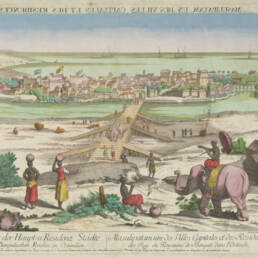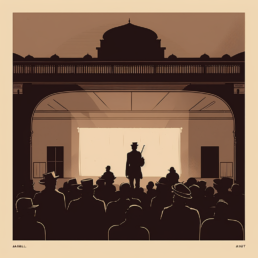As a touching display of friendship emerged between India’s Neeraj Chopra and Pakistan’s Arshad Nadeem in Budapest, we had to remember the 1956 Melbourne Olympics where two javelin throwers twisted history with an unlikely friendship that defied rivalry. A thread.
This week, Champion Neeraj Chopra, extended a warm hand of friendship to Arshad Nadeem, who secured the men’s javelin final runner-up spot. Despite initial hesitation due to the absence of the Pakistani flag, Arshad joined Neeraj in a powerful photograph.
Neeraj’s insistence on including Arshad in the snapshot spoke volumes about the unity and camaraderie that sports can foster. This touching gesture resonated not only with Indians but also warmed the hearts of Arshad’s fans across the border in Pakistan.
But their connection is no overnight wonder. The roots of Neeraj Chopra and Arshad Nadeem’s friendship go back to 2016, when Arshad entered the international arena. Neeraj, having already established himself since 2013, welcomed Arshad, marking the start of a remarkable bond.

Even more remarkable is the fact that another story of friendship across borders emerged nearly 70 years ago. The 1956 Olympics Javelin event witnessed a captivating story that might just feel like a déjà vu. Different era, different context, but an equally impactful message.
Two former comrades found themselves reunited there. Janusz Sidło, an unrivalled Polish javelin thrower, was at the pinnacle of his form, poised as the clear favourite for Olympic Gold. Meanwhile, Egil Danielsen of Norway arrived, grappling with his form and performance.
Janusz and Egil first met in Budapest in 1953, which marked the start of their unlikely friendship, despite being fierce rivals. Their camaraderie transcended differences, echoing the sentiment of true sportsmanship.
Reflecting on that time, Egil Danielsen recalled in his interview with Wojciech Zablocki, “We were different: he was very intelligent and witty, I was simple and quiet. We became very good friends, although we were strong rivals. I learned much from Sidło, especially his technique.”
Remember that: this occurred during the Cold War era, when global dynamics were sharply divided. Norway had sided with the Western Bloc, while Poland, aligned with the Soviet Union, was part of the Eastern Bloc. Amidst the iron grip of proxy war the unlikely friendship bloomed.
Fast-forwarding to the 1956 Melbourne Games, a parallel to Neeraj and Arshad’s Tokyo Olympics journey unfolded. The two friends and rivals, Sidlo and Danielsen both made it to the finals. Sidlo initially led with a massive first throw of over 78 metres.
During that era, Sidlo possessed a modern javelin made of steel, the Swedish-made “Seefab,” while Danielsen and others used traditional wooden javelins. Danielsen fondly remembered, seeing his friend’s struggle, Sidlo selflessly offered, “Why not use my steel javelin?”
Sidlo’s magnanimous gesture led him to lend his distinctive steel javelin to his friend and rival Danielsen on the grandest stage. With the new javelin in hand, Danielsen practised tirelessly. When the moment arrived, he executed a strong sprint followed by a powerful strike.
Fate took a turn as Danielsen unleashed a monumental throw of 85.71 metres, setting a new world record and securing the gold medal – a feat he could never replicate again. Guess who won the silver? The hot favourite Janusz Sidło. Yet, Sidło was the first one to congratulate Danielsen.
Although, an alternative account by Ture Widlund narrates the involvement of a Pakistani athlete, Muhammad Nawaz, who fetched the Swedish Steel javelin for Danielsen, it doesn’t take away the camaraderie among the Javelin throwers across borders.
Danielsen wrote in his memoir after making the world record: “Sidło hugged me and kissed me on the cheek, but the next to me most happy man was certainly the quick Pakistani. He had, of course, in a way a certain share in the championship throw.”
Regardless of the precise details, the friendship between Chopra and Nadeem, or Janusz Sidlo and Egil Danielsen, stand as timeless proof of sports’ universal language, where friendships can bloom, bridges can be built, and humanity can shine brighter across borders.
A parallel unfolded in 2021, mirroring the friendship of 1956 during the Cold War tensions. Amidst the simmering India-Pakistan relations, when Arshad picked up Chopra’s javelin for the Olympic finals, social media buzzed with propaganda theories.
Chopra stepped in to stand up for his Pakistani counterpart. – ”I would request everyone to please not use me and my comments as a medium to further your vested interests and propaganda. Sports teaches us to be together and united.”
“Sports teaches us to be together and united.” – has there ever been a more profound lesson than this? Thank you Neeraj.
Citations:
Nitin Sharma , India-Pakistan Javelin brotherhood: Neeraj Chopra asks a flag-less Arshad Nadeem to join him for photo at Worlds. How often have they competed in the past?, Indian Express, https://indianexpress.com/article/sports/sport-others/india-pakistan-javelin-brotherhood-neeraj-chopra-flag-less-arshad-nadeem-photo-at-world-championships-past-8912854/
Wojciech Zablocki, SETTING THE RECORD STRAIGHT, International Society of Olympic History, http://isoh.org/wp-content/uploads/2015/04/63.pdf
Ture Widlund, Setting “SETTING THE RECORD STRAIGHT” Straight, International Society of Olympic History




